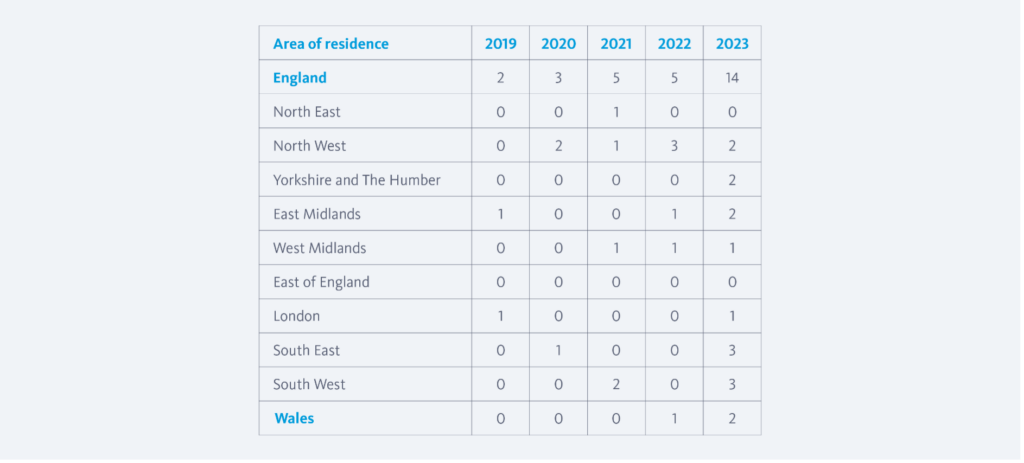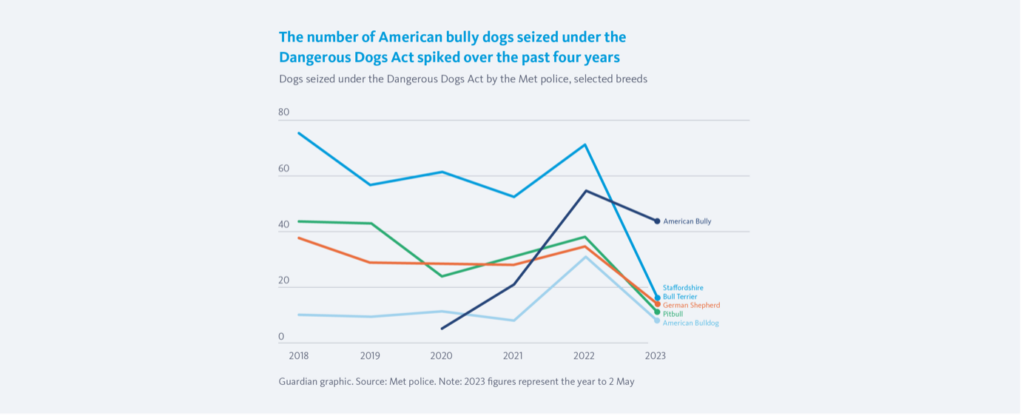May 29, 2024
In 2022, an estimated 12 million dogs were kept as pets in the United Kingdom. Between the period 2019-20 and 2021-22, the percentage of UK households with a dog increased from 23% to 34%1. The increase in pet ownership was largely due to the COVID-19 pandemic. People craved companionship as a way to improve their mental health and encourage exercise, and employees were able to work from home.
On 8 March 2023, the BBC published their findings following a Freedom of Information request made to 43 police forces. As part of their investigation, the BBC found that there had been a 34% increase in the number of offences where an uncontrollable dog had caused injury in the last five years.1
The increase in pet ownership has coincided with an increase in the number of dog bite claims received by Sedgwick — and the wider insurance industry has seen a significant increase in the number of pet insurance claims as reported by the Association of British Insurers.

The number of hospital admissions for dog bites has increased by 47% over the last 10 years as evidenced through data published by NHS Digital2. In 2012-13 there were 6,317 hospital admissions compared to 9,277 in 2022-23.3 The rise in admissions for under-18s increased by 8% in the same period. Between the financial years 2009-10 and 2017-18, it had been estimated that the direct cost of dog bite admissions was £174,188.443.4
Experts believe there are several contributing factors which have lead to an increase in dog bites, including the following:
- A significant increase in first-time dog owners who may not have known the required training or socialization their breed required — thereby increasing the risk of aggressive behaviours;
- Altered routines towards the end of the pandemic which has reduced the attention, exercise and stimulation dogs receive — resulting in frustration and separation-related behaviours;
- An increase in unregulated sellers;
- Social media trends such as “smiling” dogs and dog staring contests which can trigger aggressive responses.
On 15 November 2023, the Office for National Statistics published the following data where ‘bitten or struck by a dog’had been recorded as the underlying cause for deaths registered between 2019 and 2023 in England and Wales.

Table 1: Number of deaths where the underlying cause of death was bitten or struck by a dog, deaths registered between 2019 and 2023(p), Regions in England and Wales5
As part of the response to the Freedom of Information Request (FOI-2023-1499), the Office for National Statistics confirmed that they did not hold information confirming the breed of dog responsible. It was however reported by a UK tabloid that the XL Bully or similar breeds were believed to have been involved in 12 fatal attacks in the last three years.ii
The propensity of the XL Bully to attack and cause injury compared to other breeds of dogs was also evidenced by the Metropolitan Police force’s published data (from 01 January 2023 to 02 May 2023), which shows that 44 American Bully dogs had been seized compared to 16 of the next most common breed, the Staffordshire bull terrier crossbreed.iii

Following the deeply concerning rise in the number of dog attacks and subsequent fatalities an Early Day Motion (EDM 1159) was tabled on 11 May 2023 for debate in the House of Commons. Within the Motion text it was stated that the cost to the NHS of dog bites had been calculated at £777 million per year.[iv] The matter was subsequently debated on Monday 18 September 2023, following which the Environment Secretary and the Home Secretary convened a number of experts to define the “American XL bully” breed prior to enforcing any legislative changes.
The XL Bully breed is a variant of the wider American Bully breed, it is typically larger in terms of body shape and height than other breeds such as the ‘Micro’, ‘Pocket’, ‘Standard’ and ‘Classic’. The official definition of an XL Bully dog was updated by the Department for Environment Food & Rural Affairs on 22 November 2023.[v] Further guidance on the physical conformation standard for the XL Bully breed was updated on 01 February 2024.6
Legislative changes
The XL Bully breed was added to the list of dogs banned under the Dangerous Dogs Act 1991 on 31 December 2023vi. Under Section 1(2), it is a criminal offence to (a) breed; (b) sell or exchange such a dog or offer, advertise or expose such a dog for sale or exchange; (c) make or offer to make a gift of such a dog or advertise or expose such a dog as a gift; (d) allow such a dog of which he is the owner or of which he is for the time being in charge to be in a public place without being muzzled and kept on a lead; or (e) abandon such a dog of which he is the owner or, being the owner or for the time being in charge of such a dog, allow it to stray.
From 1 February 2024, it became illegal to own an XL Bully that is not registered on the Index of Exempted Dogs. If owners wanted to keep an XL Bully after the ban, they needed to apply for a Certificate of Exemption by 31 January 2024.
In order to obtain a Certificate of Exemption owners must obtain third party public liability insurance; neuter the dog permanently if it is not already neutered (dogs which are under one year old on 31 January 2024 must be neutered by 31 December 2024, dogs which are older than one year old on 31 January 2024 must be neutered by 30 June 2024); and pay a non-refundable fee of £92.40 for each dog they wish to keep.
For any owners choosing not to keep their XL Bully dog(s) they needed to be euthanised at a registered veterinary practice by 31 January 2024. Owners are entitled to claim compensation of up to £200 towards the cost by registering with the Rural Payments System, completing the compensation form (VCE01) with the RCVS-registered vet performing the procedure and submitting a claim by 15 March 2024.vii
From 1 February 2024 XL Bully dogs without a Certificate of Exemption or those in breach of the conditions within the Certificate of Exemption can be seized under Section 5(1) of the Dangerous Dogs Act 1991.
Concerns and potential consequences of the ban
Dave Martin, a senior vet and welfare adviser to 900 practices in the UK, has raised concerns with the BBC that there could be an increase in attacks within the home arising from a lack of stimulation and exercise following the ban. viii
The British Veterinary Association (BVA) wrote to the Department for the Environment, Food and Rural Affairs (DEFRA) on 23 November 2023ix outlining the impact the ban will have on the profession and raising a number of concerns including the following:
- A lack of understanding of the number of dogs involved (estimates range between 10,000 – 50,000) and not knowing how many dogs will be presented for neutering or euthanasia. As a result, the BVA have asked DEFRA for clarity regarding the provisions they have in place to deliver the ban if there is a lack of veterinary capacity.
- A recommendation that additional support should be provided for owners to help them type their dog as the breed standard is challenging for dog owners to interpret. Furthermore, it’s recommended that owners should be given access to Dog Legislation Officers once they have been trained.
- The uncertainty for the profession in devolved areas following the movement of dogs from England and Wales to Scotland and Northern Ireland where owners and rescue organisations are under the impression this can save dogs’ lives.
The First Minister for Scotland, Humza Yousaf, has subsequently confirmed that the safeguards imposed by Westminster will be replicated north of the border from the 23 February 2023. It will be legal to own one of the dogs but as of 23 Feburary 2023, they must be muzzled and on a lead in public. Selling or exchanging XL Bully dogs will soon be banned. From 31 July 2024, it will become an offence to own an XL bully without an exemption certificate.
Policy indemnity
In addition to the usual indemnity considerations, identifying the keeper of the dog involved is not always straightforward. Consider:
- Who had possession of the dog at the time of the incident? Was it the owner of the dog, a family member or another party?
- Does the policyholder own more than one dog, has the dog involved been positively identified and are all dogs owned by the policyholder covered under the policy?
- Is there any contractual relationship associated with the provision and use of the dog for a particular activity? Was the dog engaged in an activity for the benefit of a business?
- Is there any possibility of there being more than one ‘keeper’?
Keeper considerations
The Animals (Scotland) Act 1987 under section 5 comments on “Meaning of a keeper of an animal” and states at 5(1), “Subject to subsection (2) below, for the purposes of this Act a person is a keeper of an animal if:
- he owns the animal or has possession of it; or
- he has actual care and control of a child under the age of 16 who owns the animal or has possession of it.”
The Animals Act 1971 under section 6 comments on “Interpretation of certain expressions used in sections 2 to 5” and states at 6(3), “Subject to subsection (4) of this section, a person is a keeper of an animal if—
- he owns the animal or has it in his possession; or
- he is the head of a household of which a member under the age of sixteen owns the animal or has it in his possession.”
In Smith v Ainger and another (1990) (CA), the respondents were Philip Ainger (dog owner) and William Ainger (father of Philip Ainger). At the time of the accident, a dog (Sam) was being walked by William Ainger. In an altercation between Sam and a dog owned by Richard Smith as the Appellant, Richard Smith was injured. The court established without dispute “… (c) that both the respondents were “keepers” of Sam for the purposes of the Act; Mr Philip Ainger was the owner and Mr Wilfred Ainger had Sam in his possession at the material time.” In finding for the appellant however it was also accepted that William Ainger who had been walking the dog was not guilty of negligence. Knowledge and foreseeability on the part of the ‘keeper’ may assume importance when considering liability. In Smith v Ainger the dog owner, not the person in charge of the dog was deemed to have knowledge of characteristics.
Other insurance considerations
Once the keeper of the dog has been established, consider the policy terms and conditions. Is there an intention to provide an indemnity on a rateable proportion or a last resort basis? Pet policies are now being written on a last resort basis, only providing an indemnity in the event that any alternative cover (contents extension) has been exhausted.
Exclusions
Are there any exclusions related to dog breeds, registered under the Dangerous Dogs Act 1991? Was the dog under the control of a professional minder at the time of the incident? Have there been changes in circumstance that might impact on the original intention of the policy? Does the dog remain under the care of the owner / ‘keeper’ identified under the policy?
Learn more > We’ll continue to keep a close eye on this topic as it develops. In the meantime, visit sedgwick.com for the latest thought leadership.
[i] https://www.bbc.co.uk/news/uk-64798162
[ii] https://www.mirror.co.uk/news/uk-news/xl-bully-dogs-responsible-half-31122090
[iv] https://edm.parliament.uk/early-day-motion/60889
[v] https://www.gov.uk/government/publications/official-definition-of-an-xl-bully-dog/official-definition-of-an-xl-bully-dog
[vi] https://www.legislation.gov.uk/ukpga/1991/65/section/1
[vii] https://www.gov.uk/government/publications/claim-compensation-for-an-xl-bully-dog
[viii] https://www.bbc.co.uk/news/uk-wales-67461693
[ix] https://www.bva.co.uk/media/5530/xl-bully-ban-bva-letter-to-cvo.pdf
- Smith v Ainger (1990)



